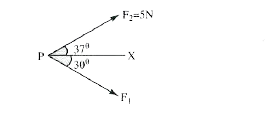In non-inertial frame, the second law of motion is written as ( where Fp is pseudo-force while a is the acceleration of the body relative to non-inertial frame).
F=ma
F=ma+Fp
F=ma−Fp
F=2ma
Step by step video & image solution for In non-inertial frame, the second law of motion is written as ( where F_(p) is pseudo-force while a is the acceleration of the body relative to non-inertial frame). by Physics experts to help you in doubts & scoring excellent marks in Class 12 exams.
Updated on:21/07/2023Topper's Solved these Questions
- LAWS OF MOTIONBOOK - AAKASH INSTITUTE ENGLISHCHAPTER - LAWS OF MOTIONEXERCISE - Assignment (SECTION-D) (Assertion-Reason Type Questions)
15 Videos
- LAWS OF MOTIONBOOK - AAKASH INSTITUTE ENGLISHCHAPTER - LAWS OF MOTIONEXERCISE - Assignment (SECTION-B)
44 Videos
- KINETIC THEORYBOOK - AAKASH INSTITUTE ENGLISHCHAPTER - KINETIC THEORYEXERCISE - EXERCISE (ASSIGNMENT) SECTION - D Assertion - Reason Type Questions
10 Videos
- MAGNETISM AND MATTER BOOK - AAKASH INSTITUTE ENGLISHCHAPTER - MAGNETISM AND MATTER EXERCISE - ASSIGNMENT (SECTION D)
26 Videos
Similar Questions
In non inertial frames,Newton's second law of motion is written as
where a= acceleration of the body, relative to the non-inertial fram and Fp is the pseudo force.
View Solution(A) : A reference frame attached to earth is a non inertial frame of reference.
(R) : The reference frame which has an acceleration is called a non inertial frame of reference.
View SolutionProblems of non-intertial frames can be solved only with the concept of pseudo force. Is this statement true or false?
View SolutionTwo frame S1 and S2 are non-inertial. Then frame S2 when observed from S1 is inertial.
A frame in motion is not necessarily a non-inertial frame
View SolutionTwo frame S1 and S2 are non-inertial. Then frame S2 when observed from S1 is inertial.
A frame in motion is not necessarily a non-inertial frame
View SolutionAsseration : Work-energy theorem can be applied for non-inertial frames also.
Reason : Earth is a non-inertial frame.
View SolutionAccording to Newton.s second law of motion, resultant force on a particle is in the direction of acceleration of the particle. Two forcce F1andF2 are acting on a particle as shown in the figure. The acceleration of the particle is along X-axis. FInd the value of F1 (in newton)

View SolutionSTATEMENT-1: Two balls are dropped one after the other form a tall tower. The distance between them increases linearly with time (elapsed after the second ball is dropped and before the first hits ground).
STATEMENT-2: Relative acceleration is zero, whereas relative velocity non-zero in the above situation.
View SolutionIn the Bohr model of hydrogen atom, the electron is treated as a particle going in a circle with the centre at the proton. The proton itself is assumed to be fixed in an inertial frame. The centripetal force is provided by the Coloumb attraction. In the ground state, the electron goes round the proton in a circle of radius 5.3×10−11m. Find the speed of the electron in the ground state. Mass of the electron =9.1×10−31kg and charge of the electron =1.6×10−19C.
View SolutionA reference frame attached to the earth
a) is an inertial frame by definition
b) can not be an inertial frame because the earth is revolving around the sun
c) is an inertial frame because Newton's laws are applicable in this frame
d) cannot be an inertial frame because the earth is rotating about its axis
View Solution
